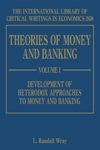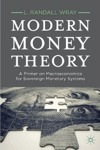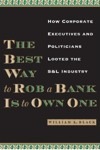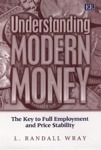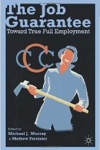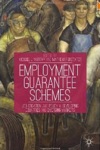Last May, John T. Harvey wrote a wonderful post about the quantity theory of money (QTM). This post picks up where John stopped, presenting a different theory of the price level and inflation. It’s a bit technical (so bare with me), but many readers have asked us to elaborate on price theory.
First, a quick recap. The QTM starts with the identity MV ≡ PQ, where M = the money supply, V = the velocity of money, P = the price level, and Q = the quantity of output (Fisher’s version is broader and includes all transactions: T). The identity is a tautology, it just says that the amount of transactions on goods and services (PQ) is equal the to the amount of financial transactions needed to complete those transactions. To get a theory of price (the QTM), one must make some assumptions about each variable. The QTM assumes that:
· M is constant (or grows at a constant rate) and is controlled by the central bank through a money multiplier
· V is constant
· Q is constant at its full employment level (Qfe) or grows at its natural rate (gn)
Given this set of assumptions, we get (note the equality sign to signal causality):
P = MV/Qfe
Or, in terms of the growth rate (V is constant so its growth rate is zero):
gp = gm – gn
This is the QTM, which holds that price changes (inflation and deflation) have monetary origins, i.e. if the money supply grows faster than the natural rate of economic growth, there is some inflation. For example, if gm = 2% and gn = 1% then gp = 1%. If the central bank increases the money supply, then inflation rises.
John’s post explains the problems with this theory. M is endogenous, V is not constant, and the economy is rarely at full employment. If you want to know more, you should read John’s post.
Let’s move to an alternative theory of the price level and inflation by starting with another identity based on macroeconomic accounting:
PQ ≡ W + U
This is the income approach to GDP used by the Bureau of Economic Analysis. It says that nominal GDP (PQ) is the sum of all incomes. For simplicity, there are only two incomes: wage bill (W) and gross profit (U). Both are measured before tax.
Let’s divide by Q on each side:
P ≡ W/Q + U/Q
We can go a bit further by noting that W is equal to the product of the average nominal wage rate and the number of hours of labor W = wL (for example, if the wage rate is $5 per hour, and L is equal to 10 hours, then W is equal to $50). Thus:
P ≡ wL/Q + U/Q
Q/L is the quantity of output per labor hour, also called the average productivity of labor (APl) therefore:
P ≡ w/APl + U/Q
w/APl is called the unit cost of labor and data can be found at the BLS. The term U/Q will be interpreted a bit later.
Ok let’s stop a bit here. For the moment all we have done is rearranged terms, we have not proposed a theory (i.e. a causal explanation that provides behavioral assumptions about the variables.) Here they are:
· The economy is not at full employment and Q (and economic growth) changes in function of expected aggregate demand (this is Keynes’s theory of effective demand).
· w is set in a bargaining process that depends on the relative power of workers (the conflict claim theory of distribution underlies this hypothesis)
· U, the nominal level of aggregate profit, depends on aggregate demand (Kalecki’s theory of profit underlies this hypothesis)
· APl moves in function of the needs of the economy and the state of the economy.
Thus we have:
P = w/APl + U/Q
Thus the price level changes with changes in the unit cost of labor and the term U/Q. What is this last term? To understand it let’s express the previous equation in terms of growth rate. This is approximately:
gp = (gw – gAPl)sW + (gU – gQ)sU
With sW and sU the shares of wages and profit in national income (sW + sU = 1).
Thus, inflation will move in relation to the growth rate of the unit labor cost of labor, which itself depends on how fast nominal wages grow on average relative to the growth rate of the average productivity of labor. As shown in the following figure, in the United States, a major source of inflation in the late 1960s and 1970s was the rapid growth of the unit cost of labor, with the rate of change between 5 and 10 percent.
Major Sector Productivity and Costs Index (BLS)
|
Series Id: PRS85006112
Duration: % change quarter ago, at annual rate
Measure: Unit Labor Costs
Sector: Nonfarm Business
Inflation will also move in relation to the difference between the growth rate of U and the growth rate of the economy (gQ). U follows Kalecki’s equation of profit, which broadly states that that the level of profit in the economy is a function of aggregate demand. Thus the term, (gU – gQ) represents the pressures of aggregate demand on the economy. If gU goes up and gQ is unchanged, then gP rises given everything else. However, to assume that gQ is constant is not acceptable unless the economy is at full employment, so a positive shock on aggregate demand will usually lead to a positive increase in gQ.
Thus, overall, there are two sources of inflation in this approach, a cost-push source (here summarized by the unit labor cost) and a demand-pull source (here summarized by the aggregate demand gap). Note that the money supply is absent from this equation. Money does not directly affect prices. Assuming that a drop of money from the sky leads to inflation, first, does not understand how the money supply is created (it is at least partly created to produce goods and services), second, assumes that people will automatically spend rather than hoard the addition funds obtained (people do hoard for all sorts of reasons and do derive “utility” from hoarding money), third, assumes that the economic output cannot respond to additional demand. If more people suddenly go to the store, producers usually produce more rather than raise prices. Output is not a fixed pie that involves allocation to one group at the expense of another group. The size of the pie increases and decreases with the number of people demanding pie.
A version of this theory has been used in many different models that have endogenous money, liquidity preference, demand-led theory of output and other non-mainstream characteristics. Godley’s and Lavoie’s Monetary Economics as well as Lavoie’s Foundation of Post Keynesian Economics are good books to get more modeling. Of course, modern mainstream monetary economics is rejected in those books; income effect dominates over substitution effect, production is emphasized over allocation, monetary profit affects economic decisions, etc. Be prepared for a change of perspective in which scarcity is not the starting point of economics.
|
|







